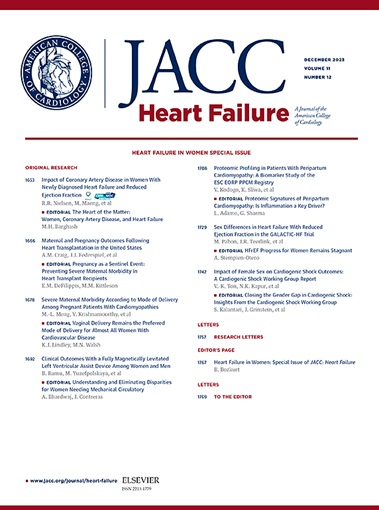Obesity and Risk of Kidney Outcomes in Heart Failure With Preserved Ejection Fraction
IF 10.3
1区 医学
Q1 CARDIAC & CARDIOVASCULAR SYSTEMS
引用次数: 0
Abstract
Background
Obesity is prevalent among patients with heart failure with preserved ejection fraction (HFpEF).
Objectives
This study aims to evaluate whether anthropometrics including body mass index (BMI), waist circumference (WC), and waist-to-height ratio (WHtR) are associated with kidney outcomes in patients with HFpEF.
Methods
In this participant-level pooled analysis of DELIVER, PARAGON-HF, TOPCAT Americas, and I-PRESERVE, we evaluated the impact of adiposity-related anthropometrics on risk of kidney outcomes (sustained eGFR reduction of ≥50%, end-stage kidney disease, or kidney-related death). BMI was collected in all trials and WC was collected in PARAGON-HF and TOPCAT. Multivariable Cox models stratified by trial and treatment were used.
Results
Overall, 16,919 participants were included in the analysis (71.9 ± 8.7 years of age; 50.7% women). Of these, 18% were normal/underweight, 35% had overweight, and 47% had obesity as assessed by BMI. WC data was available in 6,177 (105 cm; Q1-Q3: 95-116 cm), and 95% had an elevated WHtR (≥0.5). During follow-up (2.3 years; Q1-Q3: 0.6-2.9 years), 339 kidney outcome events accrued. In multivariable models, higher BMI was not associated with incident kidney events (HR: 0.99; 95% CI: 0.96-1.02; P = 0.45, per 1 kg/m2). However, higher WHtR and WC were positively and linearly associated with the risk of kidney outcomes (WC per 10 cm: HR: 1.15 [95% CI: 1.01-1.31]; P = 0.03; WHtR per 0.1 unit: HR: 1.32 [95% CI: 1.07-1.62]; P = 0.01).
Conclusions
In this participant-level pooled analysis of 4 large-scale HFpEF outcome trials, obesity and excess abdominal adiposity were highly prevalent. WC and WHtR were associated with an increased risk of kidney outcomes, while BMI was not. (Dapagliflozin Evaluation to Improve the LIVEs of Patients With PReserved Ejection Fraction Heart Failure [DELIVER]; NCT03619213) (Efficacy and Safety of LCZ696 Compared to Valsartan, on Morbidity and Mortality in Heart Failure Patients With Preserved Ejection Fraction [PARAGON-HF]; NCT01920711) (Aldosterone Antagonist Therapy for Adults With Heart Failure and Preserved Systolic Function [TOPCAT]; NCT00094302) (Irbesartan in Heart Failure With Preserved Systolic Function [I-PRESERVE]; NCT00095238)
肥胖与保留射血分数的心力衰竭患者肾脏结局的风险
背景:肥胖在保留射血分数(HFpEF)的心力衰竭患者中普遍存在。目的本研究旨在评估人体测量指标,包括身体质量指数(BMI)、腰围(WC)和腰高比(WHtR)是否与HFpEF患者的肾脏预后相关。方法在这项参与者水平的DELIVER、PARAGON-HF、TOPCAT Americas和I-PRESERVE的汇总分析中,我们评估了肥胖相关人体测量对肾脏结局风险的影响(eGFR持续降低≥50%、终末期肾脏疾病或肾脏相关死亡)。在所有试验中收集BMI,在PARAGON-HF和TOPCAT中收集WC。采用试验和治疗分层的多变量Cox模型。结果共纳入16919例受试者(71.9±8.7岁;50.7%的女性)。其中,18%的人体重正常/过轻,35%的人超重,47%的人肥胖。6177 (105 cm;Q1-Q3: 95-116 cm), 95%的WHtR升高(≥0.5)。随访期间(2.3年;Q1-Q3: 0.6-2.9年),累积了339个肾脏结局事件。在多变量模型中,较高的BMI与肾脏事件无关(HR: 0.99;95% ci: 0.96-1.02;P = 0.45,每1 kg/m2)。然而,较高的WHtR和WC与肾脏结局的风险呈线性正相关(每10厘米WC: HR: 1.15 [95% CI: 1.01-1.31];P = 0.03;每0.1单位WHtR: HR: 1.32 [95% CI: 1.07-1.62];P = 0.01)。结论在4项大型HFpEF结局试验的参与者水平汇总分析中,肥胖和腹部过度肥胖非常普遍。WC和WHtR与肾脏预后风险增加有关,而BMI则无关。评价达格列净改善保留射血分数心力衰竭患者的生活[DELIVER];与缬沙坦相比,LCZ696对保留射血分数的心力衰竭患者的发病率和死亡率的有效性和安全性[PARAGON-HF];醛固酮拮抗剂治疗心力衰竭和保留收缩功能的成人[TOPCAT];厄贝沙坦在保留收缩功能的心力衰竭中的应用[I-PRESERVE];NCT00095238)
本文章由计算机程序翻译,如有差异,请以英文原文为准。
求助全文
约1分钟内获得全文
求助全文
来源期刊

JACC. Heart failure
CARDIAC & CARDIOVASCULAR SYSTEMS-
CiteScore
21.20
自引率
2.30%
发文量
164
期刊介绍:
JACC: Heart Failure publishes crucial findings on the pathophysiology, diagnosis, treatment, and care of heart failure patients. The goal is to enhance understanding through timely scientific communication on disease, clinical trials, outcomes, and therapeutic advances. The Journal fosters interdisciplinary connections with neuroscience, pulmonary medicine, nephrology, electrophysiology, and surgery related to heart failure. It also covers articles on pharmacogenetics, biomarkers, and metabolomics.
 求助内容:
求助内容: 应助结果提醒方式:
应助结果提醒方式:


